A nice set of cookware, a good selection of knives, and quality ingredients. Those are the keys to preparing a delicious meal. In this guide, we will focus on the cutlery side of things. With countless options available, it can be an overwhelming task to determine which knives are best suited for your culinary needs. That’s why we have put together this kitchen knife buyer’s guide to help you make an informed decision.
We understand that every home cook has different preferences and uses for their knives. Therefore, our primary focus is to provide you with a variety of options that cater to a range of budgets and preferences. This guide will discuss the essential types of knives, their various uses, and what features and materials make the perfect knife.
Before diving into specific knives, it’s important to have a basic understanding of the terminology and components of a kitchen knife. This knowledge will help you make an informed decision when purchasing a new knife set and provide insight into properly maintaining and caring for your knives to ensure they last and perform at their best. With this foundation, you’ll be well-equipped to choose the perfect knives to suit your culinary needs.
Blade Materials
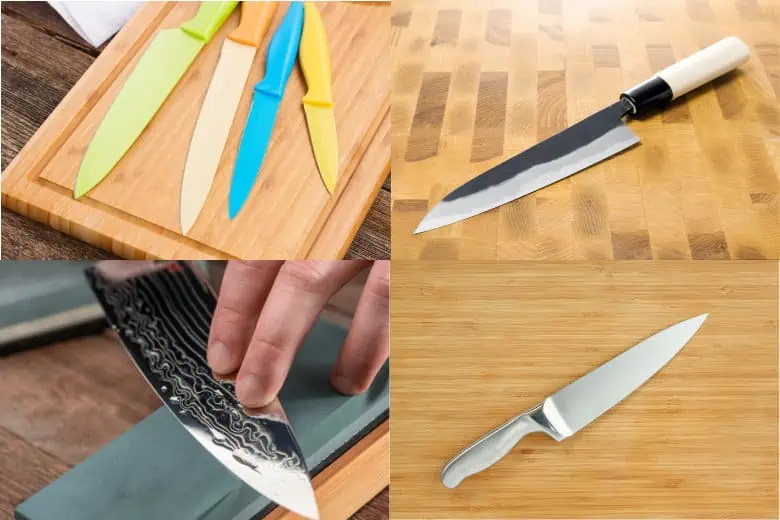
Stainless Steel
Various types of stainless steel blades are available in the market, and is the most popular choice because of its durability and resistance to rust. A notable example is 440C, a high-chromium stainless steel that gives the blade excellent edge retention and corrosion resistance. Other variations have the same beautifully descriptive names, such as AUS-10, VG10, and X50CrMoV15. Each type has a different composition of materials, such as chromium, carbon, molybdenum, vanadium, etc.
Pros
Cons
Carbon Steel
Carbon steel blades are known for their excellent sharpness and edge retention. They have less chromium content than stainless steel, making them prone to rust if improperly maintained. Some popular types of carbon steel used in kitchen knives include 1095, 1084, and Aogami. Japanese manufacturers have many carbon steel models available.
Pros
Cons
Damascus Steel
Damascus steel is a technique rather than a specific material. Layers of different steel types are forged together, creating a unique pattern on the blade. Not only does Damascus steel produce an aesthetically pleasing knife, but it can also offer a good balance between sharpness and durability.
Pros
Cons
Others
Other less common materials are used for making kitchen knife blades, such as ceramic and titanium. Ceramic blades are lightweight, extremely sharp, and rust-resistant but can be brittle. On the other hand, titanium blades are lightweight and rust-resistant, but they typically have less edge retention than steel blades.
For most home chefs, stainless steel offers the best combination of performance, durability and price.
Rockwell Scale Rating
The Rockwell Scale Rating is a way to measure how hard a material is. A higher Rockwell rating (RC60+) means the knife is harder, making it better at holding a sharp edge. However, a harder knife can also be more brittle, which means it could chip or break more easily if it is dropped or used to cut harder materials like bones.
On the other hand, a lower rating ( RC45) means that the knife is softer, making it less likely to chip or break, but it may not hold a sharp edge as well.
Handle Materials
The handle material is crucial since it’s your contact with the knife (let’s hope you’re not grabbing it by the blade!). This section will discuss three popular handle materials: wood, plastic, and stainless steel. Each has its own set of benefits and drawbacks. Let’s take a look.
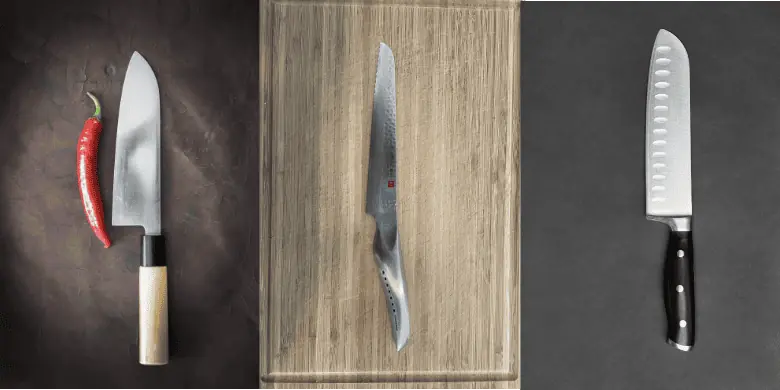
Wood
Wooden handles offer a traditional and stylish appearance. Often used in high-end knives, they provide an excellent grip and a warm, comfortable feel. Some common types of wood used in knife handles include maple, rosewood, walnut, and olive.
However, wooden handles require extra care to ensure longevity. Exposure to moisture and extreme temperature changes could cause the wood to warp or crack over time. To maintain the longevity of wooden handles:
- Hand wash knives with wooden handles and dry them immediately.
- Avoid soaking wooden handles in water for extended periods.
- Periodically oil the wood to prevent drying out.
Plastic
Typically made from polypropylene or similar materials, plastic handles are durable and low-maintenance. Plastic is the way to go if you’re looking for a practical, no-nonsense workhorse. Advantages of plastic handles include:
- Easy to clean and dishwasher-safe
- Resistant to moisture, reducing the risk of bacterial growth
- Good grip and comfortable to hold
Stainless Steel
Stainless steel handles are known for their durability, modern aesthetic, and easy maintenance. They offer the following benefits:
- Highly resistant to corrosion and moisture
- Dishwasher-safe and easy-to-clean
- Hygienic choice due to the lack of crevices for bacteria to hide
However, stainless steel handles can be heavy, which may affect the overall balance of the knife. Additionally, stainless steel handles may become slippery when wet, so it’s essential to exercise caution while using knives with this type of handle.
Understanding Knife Anatomy
There’s a specialty knife for almost every kitchen chore: carving, chopping, filleting…you name it, but they all share common features. Let’s review each one.
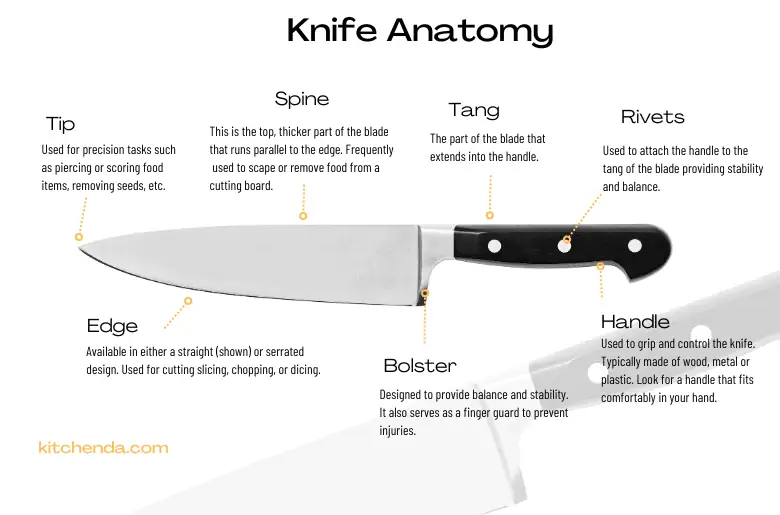
Bolster
The bolster is an important part of a kitchen knife, providing balance and stability. It is located at the junction of the blade and the handle, offering a smooth transition between the two components. A bolster adds weight to the knife, improving control during usage. Knives have either a full, half, or no bolster at all. Full bolsters offer more protection for the hand but are harder to sharpen toward the back of the blade. They also limit the use of certain grips. A half bolster solves these problems but at the cost of less protection. Many Japanese knives have no bolster at all to eliminate “unnecessary” weight.
Edge
This area of the knife blade varies in angle and shape depending on the knife’s purpose. For example, a chef’s knife usually has a double-bevel edge, which means it is sharpened on both sides. The edge angle is also important and can range from 15-22 degrees, with a lower angle offering better sharpness and a higher angle providing more durability.
Spine
The spine is the unsharpened, thick part of the blade opposite the cutting edge. It adds strength and rigidity to the knife. The spine’s width usually tapers from the base of the blade to the tip, allowing for easier handling and better weight distribution.
Tang
The tang is the part of the blade that extends into the handle. There are two types of tangs: full-tang and partial-tang. A full-tang knife has a tang that runs the entire handle length, providing increased stability, strength, and balance. Partial-tang knives have a tang that does not extend the entire length of the handle, which can make the knife less durable. Full-tang knives are generally preferred for their long-lasting nature.
Tip
The tip of the knife is the front part of the blade, which often comes to a sharp point. It is used for tasks such as piercing, slicing delicate foods, or cutting small items. The shape of the tip is based on the specific purpose of the knife; for example, a paring knife will have a pointed tip for precision tasks, while a Santoku knife might have a more rounded tip for versatility.
Handle
Lastly, the handle is the part of the knife that you grip while using it. The ideal handle should be comfortable and secure, ensuring safety and precision during use.
Rivets
Rivets are commonly used in kitchen knives to hold the handle in place and also add a decorative element to the knife’s design. The number and placement of rivets can vary depending on the style and size of the knife. Still, they are generally positioned evenly along the handle to provide a balanced and comfortable grip.
Stamped Or Forged
When choosing the perfect kitchen knife, one of the most important factors to consider is whether the knife is stamped or forged. This section will explore the key differences between these two types of knives.
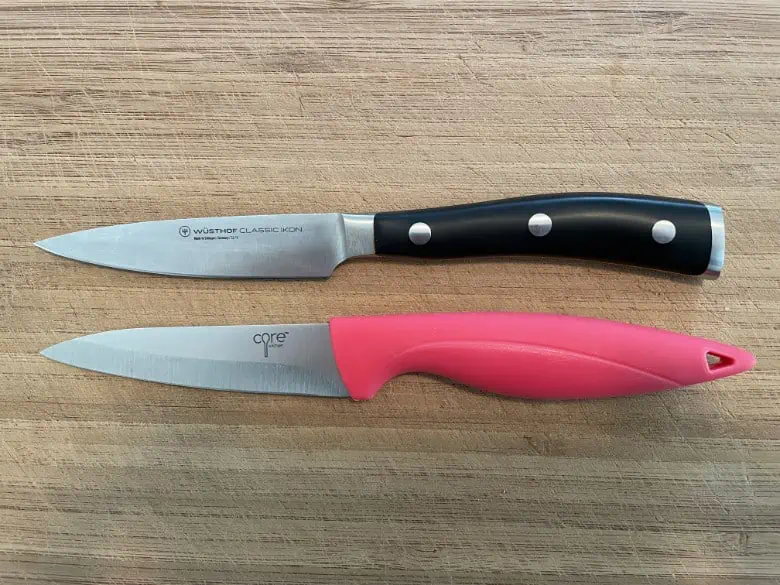
Stamped
Stamped knives are made by cutting out the blade shape from a sheet of steel and then refining the edges using a grinding process. This method typically results in lighter, thinner blades, ideal for certain tasks such as slicing fruits and vegetables. They are typically more affordable but may lack durability and may flex or bend under heavy use.
Pros
Cons
Forged
Forged knives are made by heating steel and hammering or pressing it into shape. This process creates a stronger, more durable knife with excellent edge retention. Forged knives are often preferred by professional chefs and culinary enthusiasts for their performance and longevity.
On the other hand, it’s important to consider that forged knives can be more expensive and heavier than stamped options. To make the best decision, consider the type of cooking and tasks you perform most frequently and weigh the benefits and drawbacks of each knife type. The heft of a forged knife can make cutting easier. On the other hand, if you’re faced with preparing food for hours on end, a lightweight, stamped knife can be a godsend.
Pros
Cons
Weight & Balance
When selecting a kitchen knife, one of the essential aspects to consider is its weight and balance. A well-balanced knife allows you to work efficiently and comfortably, reducing hand fatigue during extended periods of use.
Heavier knives, such as cleavers and chef’s knives, provide more power for tasks like chopping and slicing through tough, dense foods. On the other hand, lighter knives, including paring and utility knives, allow for greater control and precision when performing delicate tasks like peeling or mincing.
Blade balance is crucial in a knife’s overall feel and ease of use. A well-balanced knife should feel comfortable in the hand, with the center of gravity resting near the bolster or where the handle meets the blade. This balance ensures a smoother cutting motion and reduces the effort required.
To assess a knife’s balance, perform the following:
- Grasp the knife by its handle using a standard grip.
- Find the blade’s center of gravity by slowly moving your hand along the handle until the knife remains horizontal and doesn’t tilt.
- Note how the knife feels. It may feel unwieldy or uncomfortable if the balance point is too far forward or back.
In addition to weight and balance, materials and construction also impact a knife’s performance and durability. High-quality knives typically feature full-tang construction, meaning the blade extends through the entirety of the handle. This design provides stability and structural integrity, further contributing to a well-balanced tool.
Related: 7 Of The Best German Knives For The Home Chef
Types of Kitchen Knives
There are many types of kitchen knives, each designed for specific tasks. In this section, we’ll discuss the most commonly used kitchen knives.
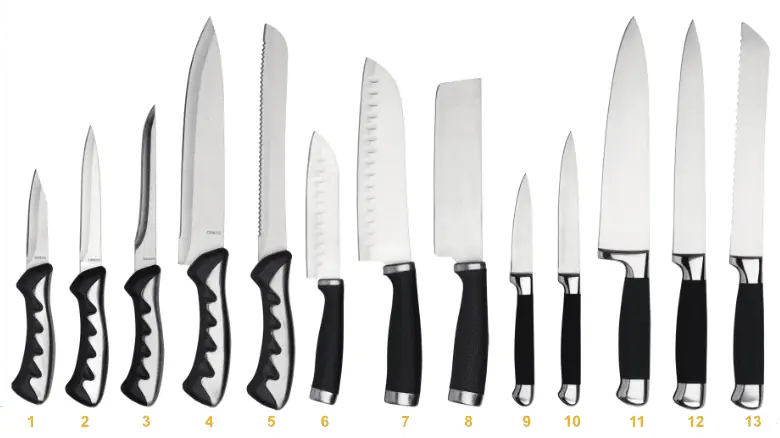
The Essential 3
If you have a limited budget or minimalist mentality, these three knives are all you need. Yes, specialty knives can make some jobs easier, but this trifecta can handle the vast majority of tasks in the kitchen.
Chef’s Knife (see #4 and #11)
A chef’s knife, also known as a cook’s knife, is a versatile kitchen tool used for various tasks, such as chopping, slicing, and mincing. It typically has a broad blade that tapers to a point and a curved edge that allows for a rocking motion while cutting.
A chef’s knife blade is usually between 6 and 12 inches long, with the most common size being 8 inches. The blade is made of high-quality steel, which allows for a sharp edge that can easily cut through meats, vegetables, and other ingredients.
Overall, a chef’s knife is THE essential tool for any home cook or professional chef, and investing in a high-quality knife is a must.
Paring Knife (see #1 and #9)
A paring knife is a small, sharp knife with a pointed blade for intricate cutting tasks. The blade is typically between 2 and 4 inches long and tapers to a sharp point, allowing for precise cuts and intricate work such as peeling, trimming, and shaping fruits and vegetables that are difficult, if not impossible, for a larger knife such as a chef’s knife. They are also useful for trimming meats and poultry and creating decorative garnishes and designs.
Bread Knife (see #5 and #13)
The third essential knife is the bread knife. The long, serrated edge of the blade allows the knife to easily cut through the bread crust without crushing the soft interior. Typically between 7 and 12 inches long and is often curved to provide a smooth, even slicing motion. They are also useful for slicing other soft foods, such as tomatoes and cakes, without crushing them.
Let’s Add To The Collection
Looking to add to your collection? While not absolutely necessary, these knives can certainly make your life easier. Let’s take a look.
Utility Knife (see #2 and #10)
Utility knives are used for a variety of tasks, such as slicing, chopping, or trimming smaller foods. They are versatile and available in serrated and straight-edged blades, measuring 4 to 7 inches long. I like a serrated version for cutting sandwiches and tomatoes.
Carving Knife (see #12)
Carving knives have long, thin blades that slice meat, poultry, and fish into even, uniform slices. They usually measure around 8 to 15 inches long and are slightly curved.
Boning Knife (see #3)
With a thin and flexible blade measuring around 5 to 7 inches in length, a boning knife is ideal for removing bones from meat, poultry, and fish. The flexibility allows for better control when separating meat from the bone.
Filleting Knife
Filleting knives have thin, flexible blades used for filleting and deboning fish. They have slightly more flexibility than boning knives and measure around 6 to 12 inches in length.
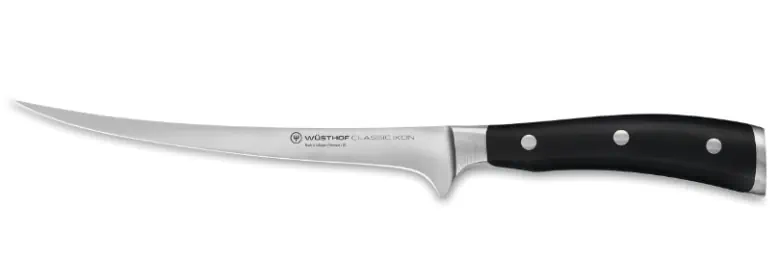
Cleaver
A Cleaver is a heavy-duty knife with a broad, rectangular blade used for chopping and cutting through bones, while its flat side is handy for crushing garlic and similar ingredients. These knives typically measure between 6 and 9 inches in length. If they look scary to you, lay off the horror movies because they really are useful.
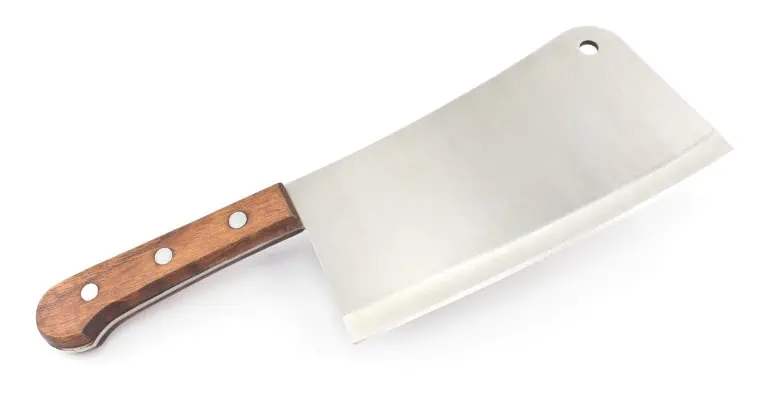
Steak Knife
Steak knives have serrated or straight-edged blades designed for easily cutting through cooked meats. They usually measure around 4 to 6 inches in length.
Electric Knife
Electric knives are powered by electricity and have two serrated blades that move back and forth, making cutting tasks like carving turkey or slicing bread faster and easier.
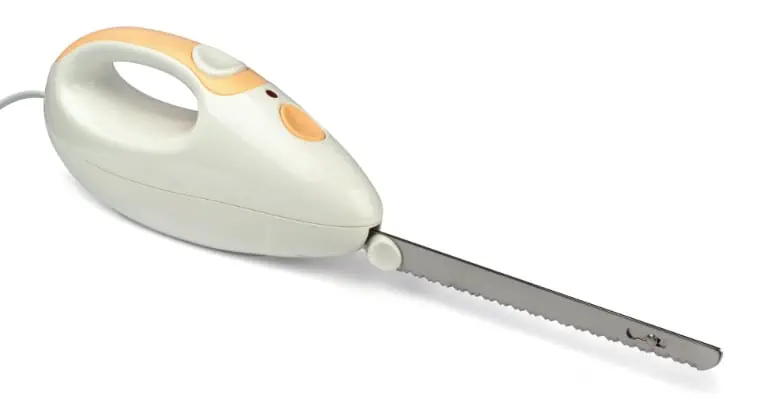
Japanese Knives
If you’re a fan of Japanese culture and cuisine, many types of Japanese knives offer their own solutions to kitchen tasks. This list will explore some of the most popular Japanese kitchen knives and their unique features.
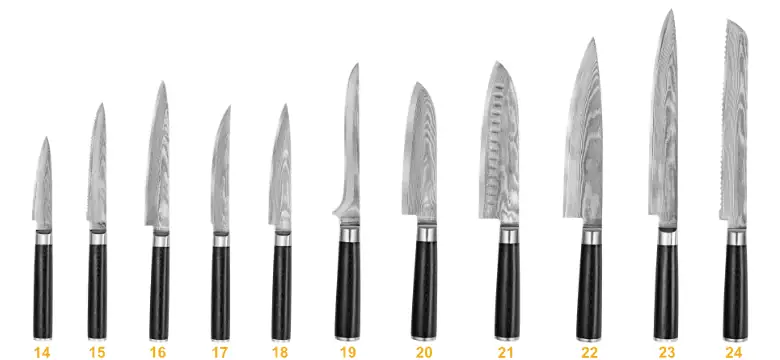
Santoku Knife (see #20 and #21)
The Santoku Knife is a Japanese all-purpose knife for slicing, dicing, and chopping. These knives have a shorter, wider blade, typically measuring 5 to 8 inches long. Incredibly versatile, they are frequently used instead of the chef’s knife.
Gyuto Knife (see #22)
The Gyuto Knife is a Japanese chef’s knife that combines the functionality of a Western-style chef’s knife and the precision of a Japanese knife. They usually have a long, thin blade measuring 8 to 12 inches in length.
Related: Santoku Vs Gyuto: Which Knife Fits Your Style Best?
Nakiri Knife (see #8)
Nakiri Knives are specialized Japanese knives for cutting and slicing vegetables. They have a straight-edged blade that allows for an up-and-down chopping motion rather than a rocking motion. After impaling my hand with a chef’s knife several years ago, the nakiri is my go-to knife in the kitchen.
Petty Knife (see #14 and #15)
A Petty Knife is a small, multipurpose knife used for delicate tasks like peeling, trimming, and slicing smaller ingredients. They have a narrow blade measuring 4 to 6 inches in length. This is the Japanese equivalent of the paring knife.
Usuba Knife
The Usuba Knife is a Japanese knife specifically designed for slicing vegetables. It has a thin, straight-edged blade for precise cuts. Similar to the nakiri but with a single beveled blade, making it a bit trickier to use.
Honesuki Knife
A honesuki is a boning knife used for poultry and other meats. Its triangular-shaped blade is thicker and sturdier than a Western-style boning knife, making it ideal for breaking down poultry and other meats with bones. The pointed tip of the honesuki knife also makes it useful for precision cuts, such as removing the tendons from a chicken breast or trimming the fat from a piece of meat.
Deba Knife
A Deba Knife is a Japanese knife traditionally used for filleting fish. It has a thick, heavy blade with a single bevel edge and tapers to a point, making it easy to cut through bones and cartilage.
Yanagiba Knife (see #23)
A yanagiba knife is used for slicing raw fish for sushi and sashimi. It has a long, narrow, thin, sharp blade with a single bevel edge designed to make precise cuts. A yanagiba is typically used with a pulling motion, allowing the blade to slice through the fish with minimal pressure. It requires a skilled hand to use properly, as the blade is delicate and can be easily damaged if misused. If you fashion yourself a budding sushi chef, this is a must-have.
Different Cutting Techniques and Matching Knives
Cutting Meat
When cutting meat, using the appropriate knives for specific tasks is essential. For boning and filleting, we recommend using a boning knife, which has a narrow, slightly flexible blade. This allows you to easily separate meat from bones and minimize waste. For slicing meat, such as chicken or beef, a slicing knife with a long and thin blade works best, as it enables making clean and precise cuts with minimal resistance.
Chopping Vegetables
For preparing vegetables, it’s important to have versatile knives that can handle different cutting tasks. A chef’s knife is a must-have in any kitchen, as it is perfect for chopping, dicing, and mincing a variety of vegetables and fruits. For smaller tasks like mincing garlic or slicing smaller fruits, a paring knife with its short, narrow blade allows for greater control and precision. If you spend a lot of time chopping veggies, a nakiri is well worth the price. With its long, straight edge, it can plow through mounds of produce in no time.
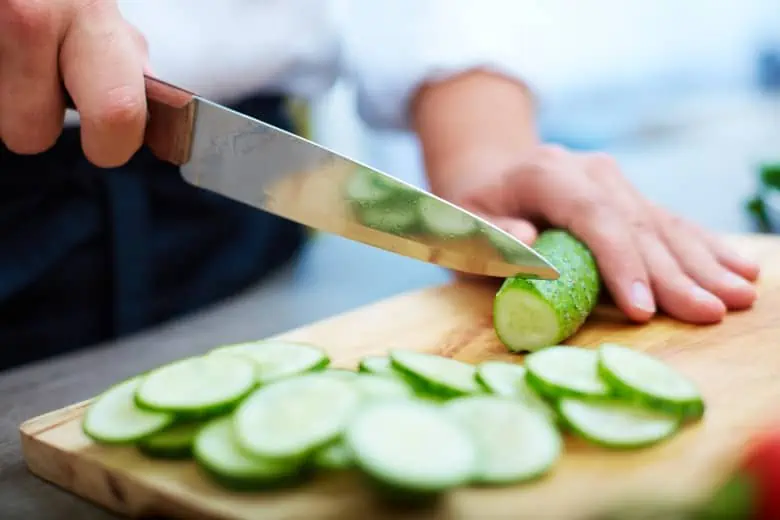
Chopping Herbs
When chopping herbs, using a knife that will not crush or bruise them is crucial. A serrated utility knife or a herb chopper are great tools for this task, as their sharp serrated edges make it easy to chop without tearing the delicate leaves. Alternatively, a chef’s knife or santoku with their curved blade can also be used for chopping herbs by rocking it back and forth on the cutting board.
Slicing Bread
Slicing bread requires a knife with a serrated edge to cut through the crust without squishing the soft interior. A bread knife with a long, serrated blade is the ideal choice for this task. It allows you to make clean slices without tearing the bread, ensuring even slices every time.
Remember to choose the right knife for each specific cutting task in the kitchen, as it will make the process more efficient, keep your knives in better condition, and improve safety while cutting.
Knife Sets
If you’re just starting out on outfitting your kitchen or just upgrading your tools, buying a knife set can make a lot of sense. We will discuss essential knives to have in a basic kitchen set and what factors to consider when looking for a quality knife set.
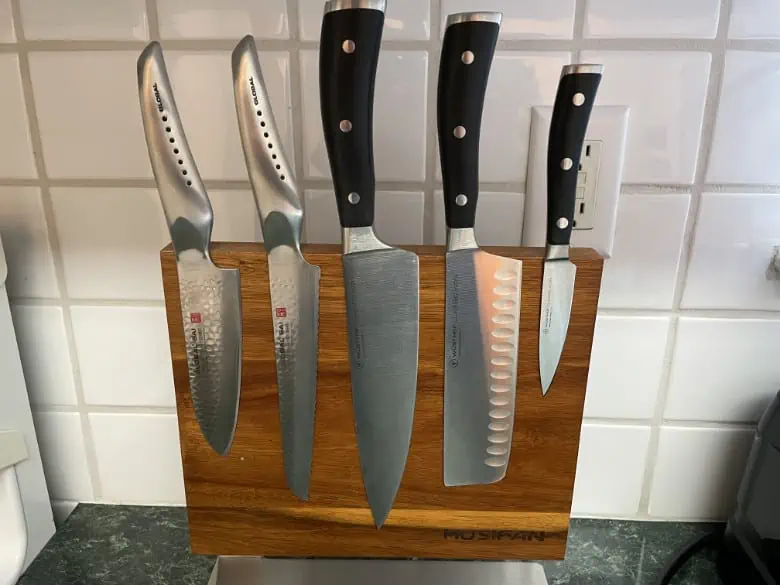
A fundamental knife set typically includes the following knives:
- Chef’s Knife: The workhorse of the kitchen, used for chopping, dicing, and slicing.
- Paring Knife: A small knife for peeling, trimming, and other precision tasks.
- Utility Knife: A versatile knife that falls between a chef’s knife and a paring knife, used for a variety of tasks.
- Serrated Bread Knife: Designed to cut through crusts without crushing, it’s a must-have for bread and delicate pastries.
When searching for a knife set, consider the following factors to ensure you’re making the best purchase:
- Blade Material: High-carbon stainless steel is the most popular choice for kitchen knives, offering excellent sharpness and corrosion resistance.
- Handle Material/Design: Look for knives with comfortable, ergonomic handles made of durable materials such as wood, plastic, or metal. Better grip and balance can reduce hand fatigue during extended use.
- Craftsmanship: Quality craftsmanship is vital for durability and performance. Look for knives with a full tang, which is when the blade extends through the handle, offering better balance and strength.
- Sharpening Tools: Keeping your knives sharp is crucial for safe and effective use. Invest in a honing rod or a sharpening stone.
When deciding on a knife set, it’s important to remember that investing in high-quality knives will pay off in the long run. Instead of buying a large, all-inclusive set, consider starting with a basic set of high-quality knives and then building your collection over time as needed.
Maintaining and Storing Your Kitchen Knives
Taking care of your kitchen knives is essential for maintaining their sharpness, functionality, and longevity. This section will discuss two important aspects: sharpening and storing your knives properly.
Sharpening Your Knives
Keeping your knives sharp is crucial for optimal performance in the kitchen. We recommend using a honing rod or sharpening stone for this task. Regular sharpening ensures that your knives remain sharp and efficient. Forged knives maintain their edge longer than stamped blades but require regular sharpening.
To sharpen your knife, hold it at a 20-degree angle against the sharpening device. Glide the blade across the honing rod or stone, applying even pressure. Repeat this process several times on each side of the knife until the edge is sharp. Read our article 5 Easy Methods For How To Sharpen A Knife for more details.
Proper Storage Solutions
When it comes to storing your knives, there are a few options to choose from.
- Knife block: A classic storage solution that securely holds your knives, protects the blades from damage and keeps them easily accessible. Select a knife block with slots that accommodate your collection of knives and ensure proper air circulation.
- Magnetic strips: Mounting magnetic strips on a wall or inside a cabinet is a modern and functional way to store your knives. This method keeps them out of reach of children, prevents damage to the blades, and helps maintain their sharpness. This is my preference as it offers more flexibility than a block.
- In-drawer knife organizer: If you have limited counter space or prefer to keep your knives hidden, an in-drawer knife organizer is a great option. Look for organizers with slots that fit various knife sizes and are lined with a soft material to protect the blades.
Remember that proper storage is essential for keeping your knives in good condition. Store them individually to prevent contact with other kitchen tools and avoid damage to the blades. Never store knives in a drawer without protection, as this can lead to dullness or even accidents while rummaging through the drawer. And, most importantly, keep all knives away from small children.
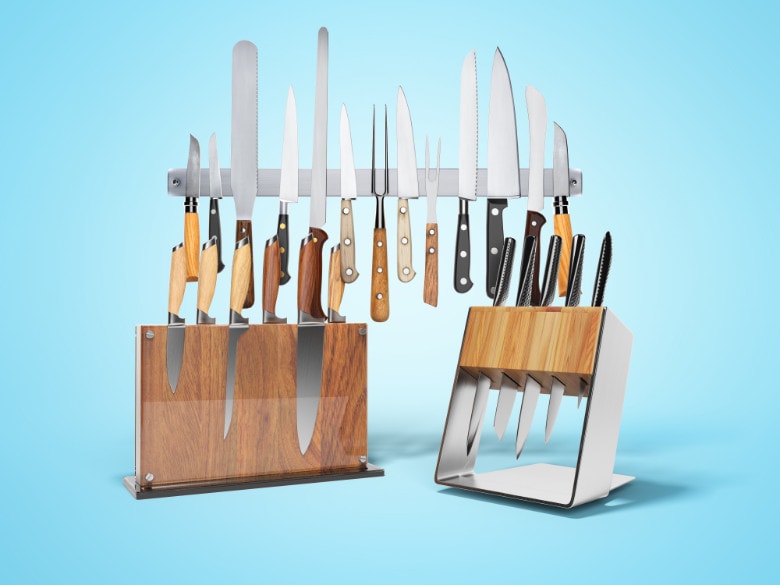
Shopping Tips
Here are some shopping tips to help in your search:
Quality is essential when it comes to kitchen knives. Look for high-quality materials like stainless steel, carbon steel, or ceramic blades. Stainless is the best choice for most home chefs as it offers good balance between durability, sharpness, and corrosion resistance. It’s worth investing in knives from reputable brands as their products often come with a guarantee.
The handle is crucial in how comfortable and secure the knife feels in your hand. Opt for ergonomic designs with slip-resistant materials, ensuring a firm and comfortable grip while working.
Maintenance of your knives is another aspect to consider. Some knives require regular sharpening to maintain their edge, while others may come with a longer-lasting blade. You should also consider the ease of cleaning, as some knives are dishwasher-safe while others must be washed by hand. Most quality knives should stay far away from dishwashers!
Lastly, your budget will significantly impact the kind of knife you choose. While it might be tempting to go for cheaper options, always remember that investing in a high-quality knife will save both time and hassle in the long run. It’s better to buy a durable, quality knife that will last for years rather than constantly replacing poorly-made knives. Not to mention it’s more environmentally friendly.
Major Brands
When it comes to kitchen knives, several major brands consistently stand out in terms of quality, craftsmanship, and performance. We will discuss a few of the most reputable brands, including Wüsthof, Zwilling, Misen, Victorinox, Global, Shun, and Yoshihiro.
Wüsthof
Wüsthof is a German brand with a longstanding tradition of excellence in knife making. They offer a wide range of high-quality knives, including their classic line, which features a full tang and triple-riveted handles for optimal strength and balance. Wüsthof also offers an innovative Ikon line that combines traditional craftsmanship with a more modern design.
Zwilling J.A. Henckels
Zwilling J.A. Henckels is another respected German brand known for its precision-forged, ice-hardened blades. Their knives often boast ergonomic handles and impressive durability. One of their popular lines is the Zwilling Pro, which offers a unique curved bolster for enhanced comfort and control. Their high-end line is under the Zwilling brand, while Henckels represents their budget-friendly offerings.
Misen
Misen is a relatively new American brand that has quickly gained popularity for its combination of quality materials and thoughtful design at an affordable price point. Their knives are made from Japanese AUS-8 stainless steel and feature a sloped bolster for improved grip and comfort.
Victorinox
The Swiss brand, famed for its Swiss Army knives, also produces high-quality kitchen knives. Like the Fibrox Pro line, their knives are known for their value and durability, featuring comfortable handles and precise, sharp blades.
Global
Another brand with a big fan base, Global is a Japanese brand that offers lightweight, well-balanced knives with a sleek design. Their knives are made from a proprietary stainless steel called Cromova 18, known for its excellent edge retention. The distinctive dimpled handle provides enhanced grip and maneuverability.
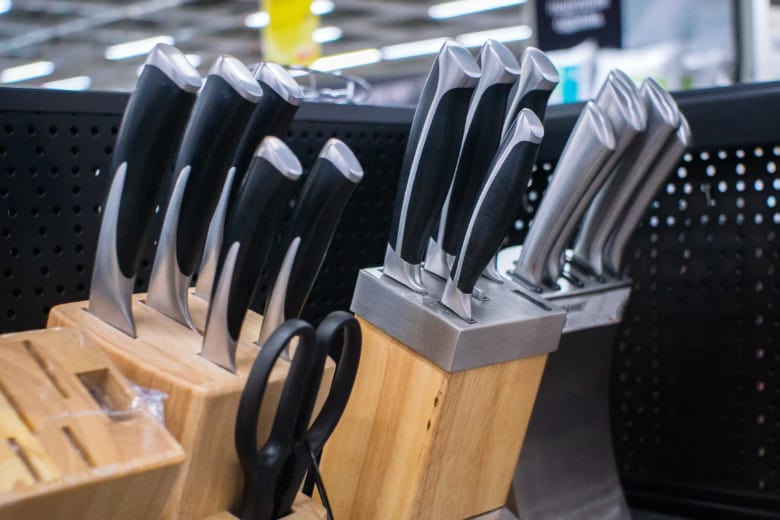
Shun
Shun is another respected Japanese brand that produces handcrafted, beautiful, and highly functional knives. Shun blades are made using a combination of VG-MAX and high-carbon stainless steel, resulting in a razor-sharp edge with impressive durability. Expensive but worth it.
Yoshihiro
A high-end Japanese brand, Yoshihiro is known for creating stunning knives hand-forged by skilled artisans. These knives offer impeccable performance and boast striking aesthetics, like the use of Damascus steel patterns and traditional Japanese handle designs.
In summary, when searching for the right kitchen knife, it’s essential to consider the reputation and offerings of these major brands. Each brand provides a unique combination of materials, design, and craftsmanship, ensuring you can find the perfect knife to suit your needs, budget, and preferences.
Frequently Asked Questions
What are the essential features of a high-quality chef’s knife?
A high-quality chef’s knife should have a sharp, durable blade and a comfortable, well-balanced handle. The blade’s material should be rust-resistant and maintain its sharpness for a long time. The tang (the part of the blade that extends into the handle) should be full or at least three-quarters to ensure stability and strength. Finally, the edge should be easy to sharpen, ideally with a honing rod or a whetstone.
How can I choose the right knife for my needs?
To choose the right knife, first consider your primary kitchen tasks and the size of your hand. For instance, a smaller paring knife suits intricate tasks, while a larger chef’s knife is ideal for chopping and slicing. Try to hold a few knives to gauge their weight and balance to find the most comfortable in your hand. Also, consider your skill level and budget when making a decision.
What are the differences between various types of kitchen knives?
Kitchen knives can be categorized into several types based on shape, size, and purpose. Some common types include:
- Chef’s Knife: A versatile, all-purpose knife with a slightly curved blade, typically 6 to 12 inches.
- Paring Knife: A small knife with a narrow, straight blade, usually between 3 to 4 inches for detailed tasks.
- Bread Knife: A serrated knife designed to cut through bread and other soft, textured foods.
- Utility Knife: A medium-sized knife with a straight or serrated blade, perfect for slicing fruits, vegetables, and sandwiches.
- Boning Knife: A thin, flexible blade for separating meat from bones.
- Carving Knife: A long, narrow blade for slicing thin, uniform pieces of cooked meats.
What factors should be considered in a knife’s durability and performance?
Key factors in a knife’s durability and performance include blade material (carbon steel, stainless steel, high-carbon stainless steel, or ceramic), sharpness and edge retention, balance, and tang length. A well-constructed knife should have a comfortable grip, smooth cutting motion, and easy maintenance.
How often should kitchen knives be replaced or sharpened?
The frequency of knife replacement depends on the quality of the blade and usage. High-quality knives can last for many years if properly maintained. Regular sharpening is necessary to maintain a sharp edge. Depending on usage, hone your knives with a honing rod every few weeks or months, and sharpen them with a whetstone or professional services every few months to a year.
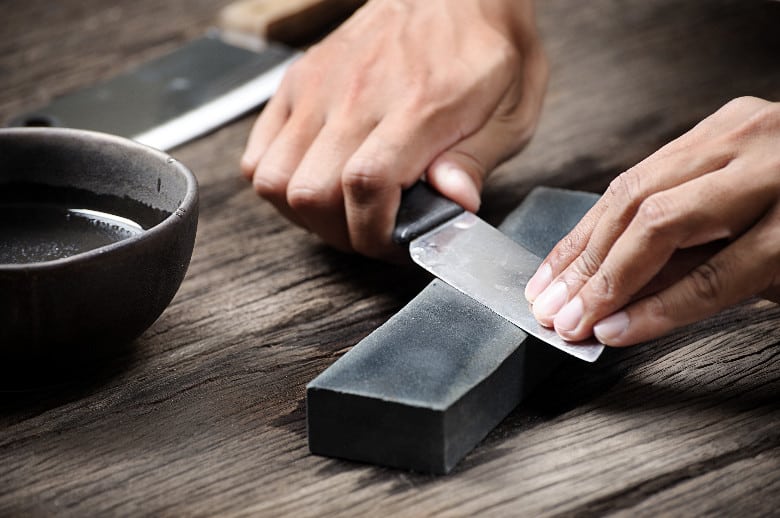
What are some recommended brands for a buyer’s consideration?
Several reputable kitchen knife brands offer durable, high-quality products. Some of our recommendations include Wüsthof, Zwilling J.A. Henckels, Victorinox, Global, Shun, Dalstrong, MAC, and Kamikoto. When selecting a brand, consider your budget, the type of knife needed, and personal preferences to find the best option for your kitchen.
Conclusion
We hope this kitchen knife buyer’s guide has equipped you with the knowledge to make a confident and informed decision. Remember that a high-quality knife is an investment in your cooking experience, and selecting the right one is crucial to your culinary success and enjoyment.
When choosing a kitchen knife, focus on your preferences and needs, such as weight, balance, and sharpness. Consider opting for a reputable brand to ensure outstanding performance and long-lasting durability.
As you build your collection, prioritize acquiring the essential knives, such as a chef’s knife, paring knife, and serrated bread knife. Feel free to expand your collection by adding specialized knives as needed.
Finally, proper care and maintenance will prolong the life of your knives. Always store your knives safely, sharpen and hone them regularly, and hand-wash and dry them thoroughly after every use. With these practices and the tips in this guide, you’re well on your way to mastering the art of knife selection and handling. Enjoy your culinary journey!
